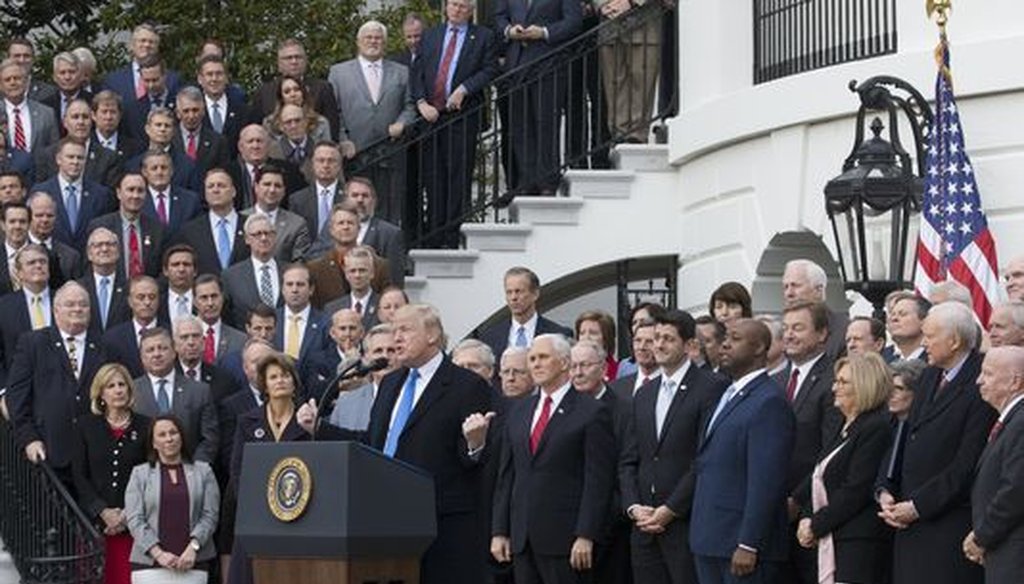



President Donald Trump and Republican lawmakers celebrated passage of the GOP tax reform bill at a White House event on Dec. 20, 2017. Does it mean $1,000 or more per year for individuals? (EPA-EFE)
Are we already just weeks away from getting savings from the new Republican tax law? And will those savings total $1,000 or more per year?
That’s the claim Republican National Committee spokeswoman Kayleigh McEnany made Dec. 27, 2017, five days after the tax overhaul was signed into law by President Donald Trump.
McEnany, who was a pro-Trump pundit on CNN during the 2016 presidential election, said it this way on Jerry Bader’s conservative talk show on Green Bay radio:
It's exciting to think that come February (2018), Americans will see their paychecks grow at the tune of saving $1,000 or more a year.
Is she right?
McEnany’s evidence
When we asked McEnany for information to support her statement, she told us she was referring to the middle class. But there was no mention of the middle class in her interview up to the point when she made her claim.
So, her claim is broad, referring simply to "Americans."
McEnany also said her statement was based largely on a PolitiFact National article that identified winners and losers in the tax bill. And she cited a list of 40 companies that say they have given their employees bonuses as a result of the tax law.
Sometimes lost in the reporting on the overhaul is that the overwhelming majority of Americans will see tax cuts, starting in 2018 and continuing for at least several years.
But, as we’ll see, many Americans -- roughly 40 percent of households -- won’t see cuts as high as $1,000 per year at all.
‘Come February’
We’ll start with McEnany’s reference to February 2018. Mark Mazur, director of the nonpartisan Tax Policy Center, told us that because of the law, some Americans likely would see somewhat larger paychecks as soon as February 2018, as employers withhold less money from employee paychecks.
That will depend on how quickly the Internal Revenue Service develops new withholding tables and then how quickly employers are able to implement them.
Now to the larger part of McEnany’s claim -- paychecks, or at least the take-home portion of paychecks, growing by $1,000 per year.
‘$1,000 per year’
The PolitiFact National article, relying on data from the Tax Policy Center, said the vast majority (about 80 percent) of taxpayers will see tax cuts in 2018.
But for Americans on the lower end of the income spectrum -- roughly 40 percent of households -- the average cut will amount to $480 or less. Meanwhile, the richer 60 percent of households will get cuts ranging from $1,090 to $285,490 (for the richest 0.1 percent).
Mazur told us those scenarios would remain the same, more or less, through 2025. After that, many of the individual tax cuts go away under the new law -- unless they would be extended by a future Congress.
At that point, Mazur said, most taxpayers will be worse off under the new law than if the law it replaced would have remained in place. In fact, by 2027, fewer than one-third of taxpayers in the bottom 80 percent of the income spectrum would see a tax cut.
(Experts from the conservative-leaning Tax Foundation, the libertarian Cato Institute and the conservative Manhattan Institute also referred us to the Tax Policy Center projections for checking McEnany’s claim.)
As for whether more companies will -- as a result of the tax law -- give their employees raises or bonuses -- is, of course, unknown.
Our rating
McEnany said: "Come February (2018), Americans will see their paychecks grow at the tune of saving $1,000 or more a year."
It’s expected that some Americans, though it’s impossible to know how many, will start seeing larger take-home pay from their paychecks in February 2018 as less money is withheld for taxes as a result of the law.
Meanwhile, it’s expected that about 60 percent of households will see tax cuts of at least $1,000 per year from 2018 through 2025. But those would largely go away after 2025, when various individual tax cuts in the law expire.
As for whether Americans in large numbers will get raises or bonuses -- because of the tax law -- that remains to be seen.
McEnany’s statement is partially accurate but leaves out important details -- our definition of Half True.
WTAQ.com, Kayleigh McEnany interview, Dec. 27, 2017
Email, Kayleigh McEnany, Jan. 2, 2018
PolitiFact National, "Who wins and who loses from the tax bill?" Dec. 19, 2017
Interview, Tax Policy Center director Mark Mazur, Jan. 3, 2018
Email, Tax Foundation analyst Amir El-Sibaie, Jan. 2, 2018
Interview, Manhattan Institute for Policy Research senior fellow in budget, tax and economics Brian Riedl, Jan. 4, 2018
Email, University of California, Berkeley economics and law professor Alan Auerbach, Jan. 3, 2018
Email, Center on Budget and Policy Priorities spokesman Jacob Kaufman-Waldron, Jan. 3, 2018
Email, Cato Institute director of tax policy studies Chris Edwards, Dec. 30, 2017
Americans for Tax Reform, "Thanks to tax cuts, Turning Point Brands to give $1,000 bonuses," accessed Jan. 2, 2018
Email, University of Wisconsin-Madison law professor Susannah Camic Tahk, whose specialties include tax law and policy, Jan. 3, 2017
In a world of wild talk and fake news, help us stand up for the facts.
